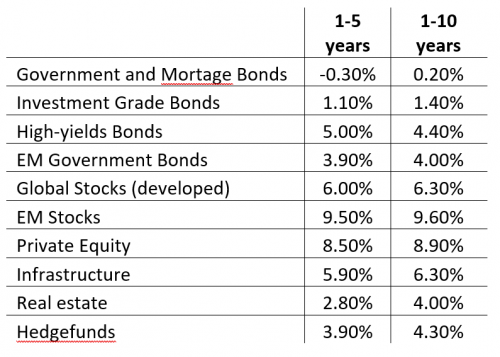New report from the Council for Return Expectations.
Overview of asset classes – incl. Alternative investments.
The Council for Return Expectations has just published a new report, in which they make some suggestions for future returns across asset classes. The report is used by pension companies and banks to compile investment forecasts and is a good starting point for an overview of recommendations and opportunities right now. The Council sets societal expectations for returns in available asset classes over the next ten years and is a useful tool for investors.
The report is particularly interesting because it compares the different asset classes available on the Danish market. The report is published twice a year and indicates an average of 4 different international expectations for the global financial markets. Based on the recent report, the expectations are as follows:
Expected annual returns in 1-5 years and 1-10 years term:

Source: Council for Return Expectations June 2020
Spread of the investment portfolio
When composing your portfolio, it is always important to spread your risk across several of the above asset classes. The very low-interest rates and the consequent low return expectations should be carefully considered before deciding what to invest in.
Equities have shown great momentum and have returned after the Covid-19 dive into the markets, and now it is at record levels. The skyrocketing in equities is now probably due to a lack of alternatives due to the low-interest rate level. Therefore, the high level of equities must be followed closely because the effects of corona can still have a significant impact on future financial results.
Asset classes with higher risks such as EM shares and private equity should be included in a diversified portfolio. It is up to the individual investor’s risk appetite to determine how much they can invest in these asset classes.
What will be the optimal investment?
I have in a previous post written about allocation to different asset classes. LINK. At the time, I concluded that a distribution in the traditional asset classes for both equities and bonds should make up 70-80% of one’s portfolio.
That said, it is also my position and recommendation that both real estate and private equity (unlisted stocks or alternative investments) should be included. Properties have a very small correlation to other of the mentioned asset classes and are a long-term investment. Private equity has a potentially high return without being notably correlated with other equity products. The chosen distribution will, of course, also be affected by age, where you are in terms of investable funds, and how high a risk you want to take.
MEGATREND INVEST is a venture company that invests in sustainable companies within specific megatrends. Our starting point is alternative investments in the form of unlisted shares with a view of investing in startups, where potential companies are carefully selected based on thorough due diligence. We believe that the companies we invest in will perform better than average based on active co-ownership. Our business is targeted at sustainable investments within specific megatrends with a future perspective. Investing in unlisted shares in sustainable entrepreneurial companies is the same as investing in the ideas that will ensure the development of our planet for many years to come.
Read the rapport from the Council for Return Expectations here.
About us
We invest in sustainable, Danish entrepreneurs and growth companies within global megatrends. Through risk diversification we ensure a high rate of return for our investors.
- CVR: 39843536
- Privacy & Cookie Policy
- Registration at the Danish FSA: FT-nr. 23.210.
- Central investor information
- Whistleblower Contact

